

Forms. The BSP Desk Reference Table of Contents. BSP Desk Reference Manual. Behavior Planning. Positive Environments, Network of Trainers. Field Studies of RTI Effectiveness Behavior Support Model (BSM) Fairbanks, S., Sugai, G., Guardino, D., & Lathrop, M. (2007).
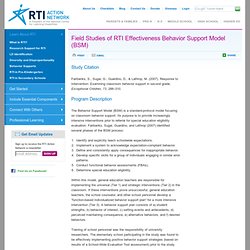
Response to Intervention: Examining classroom behavior support in second grade. Exceptional Children, 73, 288–310. The Behavior Support Model (BSM) is a standard-protocol model focusing on classroom behavior support. Its purpose is to provide increasingly intensive interventions prior to referral for special education eligibility evaluation. Fairbanks, Sugai, Guardino, and Lathrop (2007) identified several phases of the BSM process: Within this model, general education teachers are responsible for implementing the universal (Tier 1) and strategic interventions (Tier 2) in the classroom. Training of school personnel was the responsibility of university researchers. Purpose of Study The authors conducted two studies to discover whether a relationship exists between Tier 2 and Tier 3 interventions and problem behavior. Study Method. A Resource That Literally Puts Research at Your Fingertips.
As we strive to implement RtI in our schools, we want to ground our practice in sound research around instruction, teaching and learning, and assessment.

We need resources that are easily accessed, are of high quality, support best practice, and are supported at the highest level for educational quality. Quality, research-based best practice is high on everyone’s list as we create strong schools around RtI implementation. As a principal and as a special education director, I have found the “Doing What Works” Web site to be one of the best places I can go when looking for ways to improve instructional practice in my district.
Educational professionals have easy access to the research on the Doing What Works, so if you have not been there in a while, take a few minutes and look at what the site has to offer. Implementing a Combined RTI/PBS Model: SWPBS Becomes Behavior RTI. By: Deborah R.
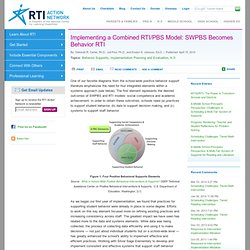
Carter, Ph.D., Juli Pool, Ph.D., and Evelyn S. Johnson, Ed.D. |Published: April 15, 2010. School-Wide Positive Behavior Support and Response to Intervention. Free Behavior Modification Charts. About.com: How to Avoid Power Struggles. Behavior Disorders and Social Emotional Issues. Behavioral and emotional disorders fall under the rubric of "Emotional Disturbance," "Emotional Support," "Severely Emotionally Challenged," or other state designations.
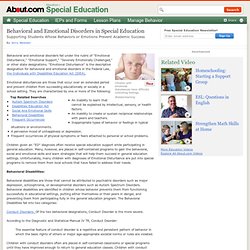
"Emotional Disturbance" is the descriptive designation for behavioral and emotional disorders in the Federal Law, the Individuals with Disabilities Education Act (IDEA). Emotional disturbances are those that occur over an extended period and prevent children from succeeding educationally or socially in a school setting. They are characterized by one or more of the following: An inability to learn that cannot be explained by intellectual, sensory, or health factors. Lincoln-Titus ES. Building Character With PBIS Dear Parents, Welcome to the 2010-2011 school year.

We all look forward to the many wonderful experiences ahead. In the past several years, Lincoln-Titus has developed a successful character education program. As part of a district-wide initiative, Lincoln-Titus has also been implementing a new Positive Behavioral Interventions and Supports model. Successful Schools, Inc. Positive Beginnings. Positive Connections: CPI and Positive Behavior Support. Make a Positive Connection!
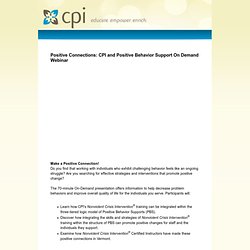
Do you find that working with individuals who exhibit challenging behavior feels like an ongoing struggle? Are you searching for effective strategies and interventions that promote positive change? The 70-minute On-Demand presentation offers information to help decrease problem behaviors and improve overall quality of life for the individuals you serve.
Top 10 PBIS Online Resources. As your organization implements Positive Behavioral Interventions and Supports (PBIS), you may have looked to the Internet for more information.
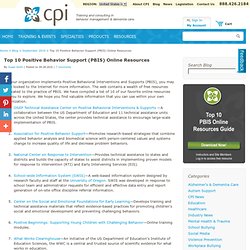
The web contains a wealth of free resources dedicated to the practice of PBIS. We have compiled a list of 10 of our favorite online resources for you to explore. We hope you find valuable information that you can use within your own organization. OSEP Technical Assistance Center on Positive Behavioral Interventions & Supports —A collaboration between the US Department of Education and 11 technical assistance units across the United States, the center provides technical assistance to encourage large-scale implementation of PBIS. Page not found. 087628909X_55.pdf (application/pdf Object) Getting Along. Teaching Shortcuts. DBR - Information for Parents and Professionals. Behavior Plan Creator. DBR%20Booklet%20Printing%20Instructions. DBR - Home. What is Direct Behavior Rating (DBR)?
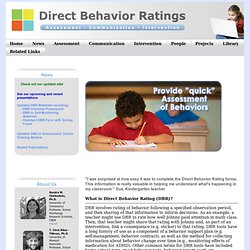
DBR involves rating of behavior following a specified observation period, and then sharing of that information to inform decisions. As an example, a teacher might use DBR to rate how well Johnny paid attention in math class. Then, that teacher might share that rating with Johnny and, as part of an intervention, link a consequence (e.g. sticker) to that rating. DBR tools have a long history of use as a component of a behavior support plan (e.g. self-management, behavior contract), as well as the method for collecting information about behavior change over time (e.g., monitoring effects of medication for ADHD). Other common terms for DBR tools have included home-school note, good behavior note, behavior report card, etc...
Behavior Report Card Generator. Intervention Central. Mozilla Firefox. Functional Behavior Analysis: FBA sounds much more complicated than it really is and anyone who tells you different is mistaken.
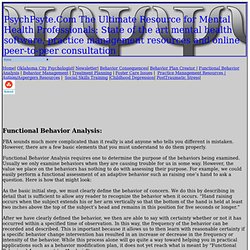
However, there are a few basic elements that you must understand to do them properly. Functional Behavior Analysis requires one to determine the purpose of the behaviors being examined. Usually we only examine behaviors when they are causing trouble for us in some way. However, the value we place on the behaviors has nothing to do with assessing their purpose. As the basic initial step, we must clearly define the behavior of concern. Differential reinforcement procedures: How to use them. DRprobs. FBA: Functional behavior assessment. FUNCTIONAL BEHAVIORAL ASSESSMENT (FBA) As required by IDEA - (Pertains to educational law in the United States) Introduction Functional behavioral assessment (FBA) is a variation on procedures originally developed to ascertain the purpose or reason for behaviors displayed by individuals with severe cognitive or communication disabilities (e.g., individuals with mental retardation or autism).
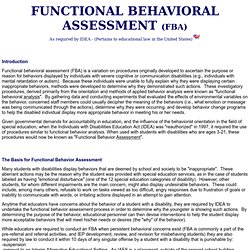
Because these individuals were unable to fully explain why they were displaying certain inappropriate behaviors, methods were developed to determine why they demonstrated such actions. These investigatory procedures, derived primarily from the orientation and methods of applied behavior analysis were known as "functional behavioral analysis".
Parenting children with behavior problems and challenges. Welcome Parents! On this page you'll find a number of items that are directly related kids who present their parents and teachers with behavioral challenges. After the listing of articles, you'll find a list of helpful books, followed by some excellent web sites for parents of children who have emotional and/or behavioral hurdles to overcome. *Clicking on the images of books that you see below, will take you to Amazon.com where you can preview the texts and decide whether to purchase them. These books can be purchased at any on-line book store, but buying them from Amazon.com (after clicking on these icons) supports www.BehaviorAdvisor.com A small percentage of the purchase price is returned to this site. Great Books For Parents Of Kids Who Need To Learn To Make Better Behavior Choices This classic book, as useful today as when it was first published in the early 1980's provides parents with "Nice ways" to gain compliance from their children.
Author: Tom McIntyre at www.BehaviorAdvisor.com. Classroom Behavior Management Strategies by Dr Mac. The solutions you seek are on the other side of this form. Gaining access to this treasure trove of hundreds, perhaps thousands of strategies, tips, and interventions is a quick process. Enter your name (or other identifier that you prefer) & e-mail address in the boxes below. You'll then be asked to check your e-mail box for a message from BehaviorAdvisor.com.
Home. Mozilla Firefox. Center on Enhancing Early Learning Outcomes (CEELO) The Center on Enhancing Early Learning Outcomes (CEELO) works to strengthen the capacity of state education agencies (SEAs) to lead sustained improvements in early learning opportunities and outcomes. Resources on this site include publications, webinars, and presentations about EI/ECE assessment, as well as links to other centers. The CEELO Annotated Bibliography on Early Childhood Assessment highlights resources found on the Website. This center works in partnership with SEAs, state and local early childhood leaders, and other federal and national technical assistance providers to promote innovation and accountability. To help SEAs improve services for infants, toddlers, and young children, resources on this site include publications, webinars, presentations, and links to other Websites for various topics: assessment, data, practices for children from birth through third grade, workforce, systems, and child outcomes.
Teacher Behavioral Strategies: A Menu. Here is a sampling of strategies that teachers can use either to head off or to provide consequences for low- to medium-level student misbehavior: Prior to Occurrence of Behavior(s): Break student tasks into manageable 'chunks': Students may misbehave to escape activities that they find too hard or tedious.
Consider breaking a larger task into smaller or easier 'chunks' that the student will more willingly undertake. If the student must complete a large number of subtasks, include an occasional 'fun break'. Discipline Help: You Can Handle Them All. Teachers TV - The Department for Education. Teachers TV. Brandt Publishing: Discipline for Home and School, Revised and Expanded Edition, Chapter 18. Classmanpart7 « Behaviour Needs.